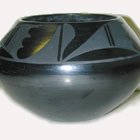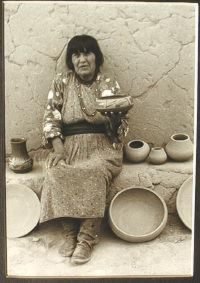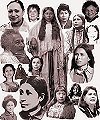 |
Ancient
Voices
A
Museum to honor the least known people in North America, the Original
Tribal Women |
Pottery
San Ildefonso and Santa Clara
San Ildefonso Pueblo is a quiet community located 20 miles northwest of Santa Fe, New Mexico. Inhabited since A.D. 1300, the pueblo saw many changes that resulted in a rich culture, in which ancient traditions mix with Spanish festivals and Anglo conveniences. Life in the Tewa-speaking village on the Pajarito Plateau is filled with love for one's neighbor and respect for the God-given gifts of the earth.
The beautiful Indian pueblo lies suspended in the mysterious shadow of the Black Mesa. San Ildefonso is like a world of its own. Village history is found in the hearts of the people, through their wonderful stories and images of the past. Among their stories is the famous legend of the Black Mesa and its, "giant," the local bogey man.
Not only is San Ildefonso known for its legends but for its religion and art work as well. Art isn't only found in paintings and pottery but in delicious foods and ancient healing remedies
The Pueblo of Santa Clara was established around 1550 in its current location when a drought forced their ancestors to move into the Rio Grande Valley. The people of Santa Clara can trace their ancestry to the occupants of a cliffside village known as the Puye Cliff Dwellings. The stunning ruins were built alongside a cliff face in the Santa Clara Canyon and are open to visitors year round. The Pueblo itself is located about a mile and a half (2.4 kilometers) south of Española.
Santa Clara is a Tewa tribe located twenty-five miles north of Santa Fe, New Mexico on the west bank of the Rio Grande. Santa Clara has more potters than any other pueblo. They produce various styles, types, colors and sizes ranging from large traditional ollas to fine incised miniatures. Almost all of the pottery made today is signed.
Since 1930 women have been experimenting with designs of matte (lusterless) black on polished black like those first made at the San Ildefonso pueblo. There are two vessel shapes that are distinctly Santa Clara: the wedding jar; a double-necked jar with two mouths connected by a handle, and a high necked wide mouthed jar with a squat body.
|
Maria Martinez
1884 (?) - 1980
Maria Antonia Montoya was born, probably in the year 1884. For nearly one hundred years, until her death in 1980, Maria lived in the pueblo, spending all of her years in the place where she was born: San Ildefonso Pueblo in northern New Mexico, about 20 miles from Santa Fe. Pottery making had been an important part of her culture for more than 2000 years also she came from the same lineage of Christina Naranjo and Sarafina Tafoya so it is no wonder that she and many Montoya/Martínez family members were also involved in producing pots. Maria is probably the most famous of all pueblo potters yet she was always eager to greet visitors and to share her craft with those who would like to watch and listen.
Not long after her marriage to Julian in 1904, Maria was asked to replicate some pre-historic pottery styles that had been discovered in an archaeological excavation of an ancient pueblo site near San Ildefonso. These excavations of 1908 and 1909, led by Dr. Edgar Lee Hewett (who was also the director of the Museum of New Mexico), produced examples of many pre-historic pottery techniques. Dr. Hewett asked Maria, who already had a reputation in the pueblo for being an excellent pottery-maker, if she could make full-scale examples for the museum of the polychrome ware. It was then that Maria and Julian (who painted the designs on the pottery after Maria shaped them), began an artistic collaboration that would last throughout their lives together. She and Julian, discovered in 1918 how to produce the now-famous black-on-black pottery and they spent the remainder of their careers perfecting and producing it for museums and collectors worldwide.
Although she had not had any formal schooling, Martínez was awarded two honorary doctorates, had her portrait made by the noted American sculptor Malvina Hoffman, and in 1978 was offered a major exhibition by the Smithsonian Institution's Renwick Gallery. Maria and Julian received the Best of Show at the Century of Progress, Chicago World's Fair in 1933 and were invited to the White House by President Theodore Rooseveldt. In 1939 they made their pottery at the San Francisco World's Fair.
Julian passed on to the spirit world in 1943, and other family members stepped in to help Maria with her work
Allen Hayes writes: " In 1974, Maria Martinez was assured lasting prominence when she was honored along with Rose Gonzales as one of the two matriarchs from San Ildefonso Pueblo in the Seven Families in Pueblo Pottery exhibit. Maria's fame came from her black on black ware, while Rose's came from her superb carved ware."
Publications about Maria Martinez
- The Living Tradition of Maria Martinez, by Susan Peterson . 1977. Kodansha International, New York.
- Maria, by Richard L. Spivey. 1979, second printing 1981. Northland Publishing.
- The Legacy of Maria Poveka Martinez, by Richard L. Spivey. 2003. Museum of New Mexico Press.
- Maria, The Potter of San Ildefonso, by Alice Marriott. 1948. First edition. University of Oklahoma Press.
- Maria Montoya Martinez, Master Potter, by Elsie Karr Kreischer, Pelican Pub. (Ages 9-12)
- Tending the Fire: The Story of Maria Martinez, by Juddi Morris, Rising Moon (Northland) (Ages 9-12)
|
Rose Gonzales
1900 - 1989
Rose was born at San Juan Pueblo in 1900 and, soon after, became an orphan when her parents died from the flu epidemic. She survived by attending the Santa Fe Indian School.
She married Robert Gonzales of San Ildefonso Pueblo and moved to his pueblo at that time. She learned the art of pottery making from his mother.
Rose experimented for years with blackware, redware, Black-on-black ware and carved ware. She became very proficient at all of these.
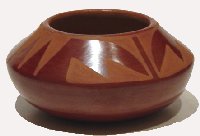
Rose Gonzales was one of the early innovators of deeply carved pottery at San Ildefonso pueblo in the 1930's. However, she also did painted pottery in addition to the carved pieces. This is an early example of her pottery as it is a red on red bowl, as opposed to the later use of the cream colored slip used on red pottery.
Gonzales introduced her own design innovations, which added to the variety of excellent wares being produced at the Pueblo. The Martinez's and other potters applied paint to their pieces for design elements, but Gonzales carved her designs into the blackware, providing a contrast and complement and spinning off a new style that became popular and well-regarded.
Allen Hayes writes: " In 1974, Rose Gonzales was assured lasting prominence when she was honored along with Maria Martinez as one of the two matriarchs from San Ildefonso Pueblo in the Seven Families in Pueblo Pottery exhibit. Maria's fame came from her black on black ware, while Rose's came from her superb carved ware. This is a flawless example of the style that brought Rose her recognition."

Publication
"Rose Gonzales," by Nancy Fox, American Indian Art Magazine, Autumn 1977
|
Anita Suazo
1939 -

Daughter of noted Santa Clara potter Belen Tapia, Anita learned to pot from her mother as a small child. She has been potting ever since and it has been her career for her adult life.
With her husband Joseph, Anita collects her clay from the lands of the pueblo itself and uses only traditional techniques in creating her work. She decorates her work in designs including rain clouds, kiva steps, feathers, squash, and the avanyu. Her pottery specialties include red and black carved pieces, as well as red polychrome and black-on-black pots.
Considered a master potter, Anita creates redware and blackware pots using the centuries old coiling technique. Anita has taught pottery at UNM and at UC Davis. Her work is highly sought by collectors around the world and is in museum and private collections across the country.
Anita has won over a dozen awards at each of three competitions, Santa Fe Indian Market, the New Mexico State Fair, and at the Eight Northern Pueblo Artists and Craftsman Show. These awards include the "Best in Show" at the 1985 NM State Fair; the Jack Hoover Memorial Award at the Santa Fe Indian Market in 1986; and most recently a second place ribbon at the 2004 Eight Northern Show and one second & one third place ribbon at the 2004 Santa Fe Indian Market. Anita has taught traditional Indian pottery techniques at the University of New Mexico and at the University of California at Davis. Her work is in many museum collections including the Heard Museum of Phoenix, the Millicent Rogers Museum of Taos, the Wheelwright Museum of Santa Fe, and the Smithsonian Institution of Washington, D.C.
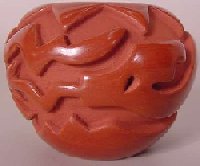
|
Gwen Tafoya
1964 -
Gwen Tafoya was born into the Santa Clara Pueblo. She is the granddaughter of Severa Tafoya and Cleto Tafoya.
Gwen was inspired to make pottery by her mother, Mary Agnes Tafoya, who taught Gwen all the fundamentals of hand coiling traditional Santa Clara Pottery. Gwen began making larger pieces of pottery by the time she reached the age of 16, and eventually would etch on the pottery steadily. Gwen works with sgraffito blackware bowls and jars and her work is absolutely stunning. Gwen is best know for her extensive floral sgraffito designs and sculptured rims.
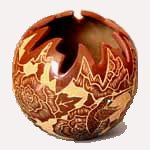 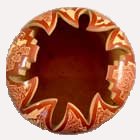
Gwen's work continues to become increasingly refined with greater detail and design flow making her sgraffito work among the best.
She has won several awards for her work including Best Of Show, First and Second Place at the Inter-tribal Ceremonial in Gallup, New Mexico; the Eight Northern Indian Pueblos Arts & Crafts Show; and the New Mexico State Fair.
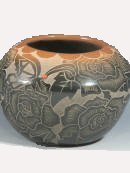
Her work is highly valued and widely collected and is included in Dr. Gregory Schaaf's book "Southern Pueblo Pottery: 2,000 Artist Biographies" and in "Contemporary Pueblo and Navajo Pottery" by Berger and Schiffer.
|
Dora Tse-Pé
1939 -
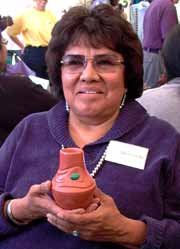
Dora is from Zia Pueblo and married into San Ildefonso Pueblo. Dora has been exhibiting her work since 1969 and is continuing to win awards to this day. She is known for her exquisitely polished pottery in both blackware and redware. She learned pottery making from her mother Candelaria Gachupin and grandmother Rosalie Toribio. She was also greatly influenced by Maria Martinez' son Popovi Da and his son Tony Da. Dora's mother-in-law is Rose Gonzales, who also married into San Ildefonso Pueblo from Zia and is recognized as the innovator of deeply carved pottery. Rose was a great influence on Dora as well.
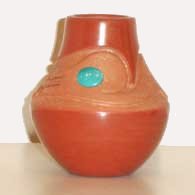
Dora was recently honored as one of the Masters of Indian Market in Santa Fe. She is featured in almost every book on Pueblo pottery published today.
|
|
Please click on the links below to see the various pottery families.
|



